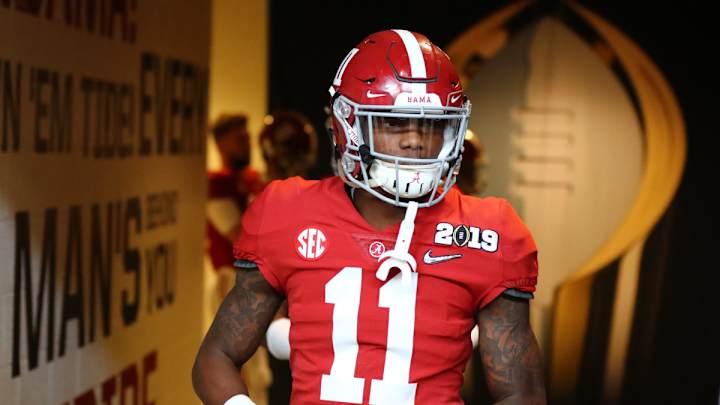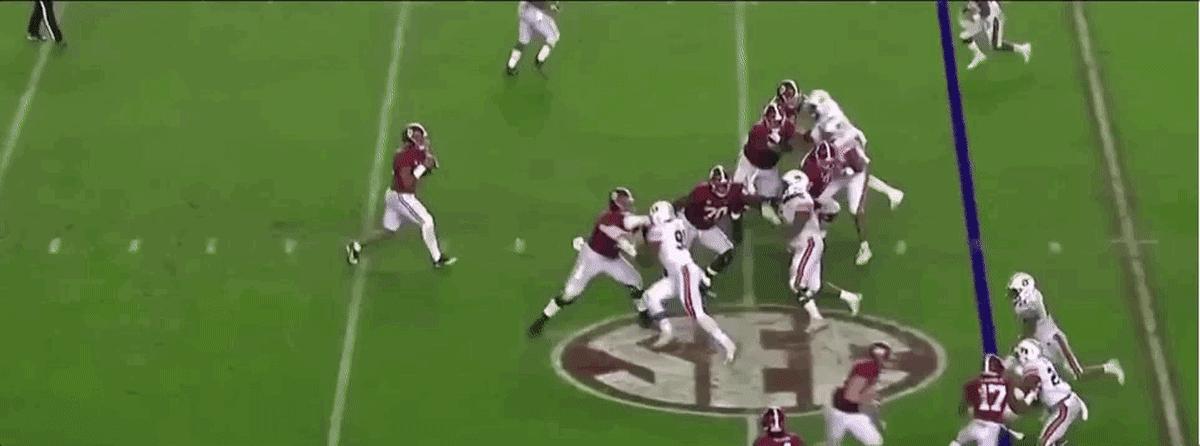PatriotMaven Scouting Profile: Henry Ruggs III

Let's start off by saying: Henry Ruggs III of Alabama is really good. He is likely the third best receiver in this draft class, which says a lot. This draft class, in terms of wide receivers, is undoubtably the deepest it has been in a while. Which is very convenient for a receiver-needy team like the New England Patriots.
Ruggs may be a guy the Patriots would have to trade up for. Lots of mock drafts have him going a hair before New England's selection at no. 23. However, if it means parting with some additional picks to ensure Ruggs lands with in New England, it is almost certainly worth it.
Here is Ruggs' draft profile, which will help answer why he is so good and why he would fit so well in New England:
Hands/Tracking
- He has outstanding mitts. Ruggs has natural hands. Whether he is catching the ball wide open on a comeback route or leaping up to grab it, he is strong in that department.
- He high-points the ball well in the air and can be used in the red zone for jump-ball situations against less physical defenders.
- Ruggs does a nice job with putting his hands up "later" to track and catch the ball and give his defender very little time to adjust to the ball.
- His tracking skills are top notch
Speed and athleticism
Be prepared for the post-combine hype that will follow Ruggs. He will in all likelihood run the fastest 40-yard dash there. He will likely combine that with a solid vertical leap for his size. He is primed to have a combine that will leave everyone talking.
Ruggs is undoubtably athletic. He could give up football for the Olympics, if he wanted to. He has some outstanding speed and he seems to always have another gear to evade incoming tacklers.
Size
Ruggs may be 6-foot but he is a lean 190 pounds. This here is one of the knocks on him as he lacks the muscle and size to really hang with more physical corners. He can compensate for it with his outstanding athleticism. However, a bigger, more physical corner who could bump him at the line of scrimmage and then pass him off to a speedy safety would disrupt the smaller speedster for sure.
Route-running and separation
Ruggs is not the best route-runner in this class. In fact, he may not even be a top five guy in that department. Yet he showed strong signs of progression from two years ago to this last season. The hope is that he will continue to improve in that department.
Route-running was a struggle for Patriots receiver N'Keal Harry at times last season. However, Mohamed Sanu and Julian Edelman are both some of the league's strongest in that department. If Ruggs were to come here, hopefully the two vets could harp in on sharp route-running technique to the two youngsters.
In regards to gaining separation, Ruggs has the blazers to get away from any defender. Leaving a defender on an island with him will simply not work as that is like lining up and racing a cheetah.
Smarts and awareness
There were some encouraging instances this year where Ruggs appeared to make some pre-snap reads himself and cut his route off to get open. More than that, he has demonstrated a solid understanding of his landmarks, his timing, and the game itself. He also appears to have a solid understanding of technique against man coverage and always finds himself open in zone coverage.
Physicality
Ruggs is really tough. He is a scrappy, little guy. However, physicality is his biggest weakness.
His frame is just too small and he just struggles to fight through contact when bumped at the line. College corners were somewhat afraid to bump a guy like Ruggs because of his athleticism in college. However, in the NFL, guys are bigger, more physical, and quicker.
Ruggs did not see a lot of bumping at the line in college. But when he did, the film was not so good. There will be less free releases for Ruggs in the pros, which will certainly be a test for him to fight through more contact.
Blocking
This may shock some, but Ruggs might be one of the better blocking receivers in this class. Despite his small, lean frame, his scrappy, tough nature helps him take care of defenders in the run game. While he is certainly no Trent Brown coming off the edge, he does a good job keeping guys out of the play and giving his runningback an outside lane to run through. He appears to enjoy blocking, which is always a good sign for a receiver prospect if you value your receivers being able to block.
Production
Ruggs' stats were tampered a bit by being in one of the most talented receiver rooms in college football history at Alabama/ Some notable partners throughout his three year career consisted of Jerry Jeudy, Jaylen Waddle, DeVonta Smith, and Calvin Ridley.
Ridley was a first round pick for the Falcons and has put up solid numbers in his first two seasons next to Julio Jones. Jeudy is projected to go in the top 10 of this year's draft and is the consensus number one receiver on almost every big board. Lastly, Waddle and Smith with both be returning to Alabama next year and will likely be selected in the first two rounds of their draft class. Point being - Ruggs' numbers were great despite fighting all of those stud receivers for targets.

The real way to tell production is his average yards per catch. The lowest average he had out of his three years at Alabama was 16.1, which even that low should be pretty mouth-watering for the Patriots' draft room.
Film




Fit
Ruggs on the Patriots would not just be a speedy, dynamic toy for Tom Brady (assuming he is back next year) but also would be a guy who, above all else, would require attention from opposing defenses.
Think about the work that goes into covering a speedster like Tyreek Hill, or even a rookie from last year like Marquise Brown. Receivers with that kind of speed could have the worst hands in the world but because of their big play ability, they have to be covered.
That same game plan would have to be employed on a guy like Ruggs. Even if he is not the number one target for Brady, he is still a threat to break free at any moment. That threat opens up lanes for and takes pressure off of guys like Edelman or Harry, allowing them to flourish. It makes game planning easier, favorable matchups more likely, and asks less of the other receivers on the depth chart.
